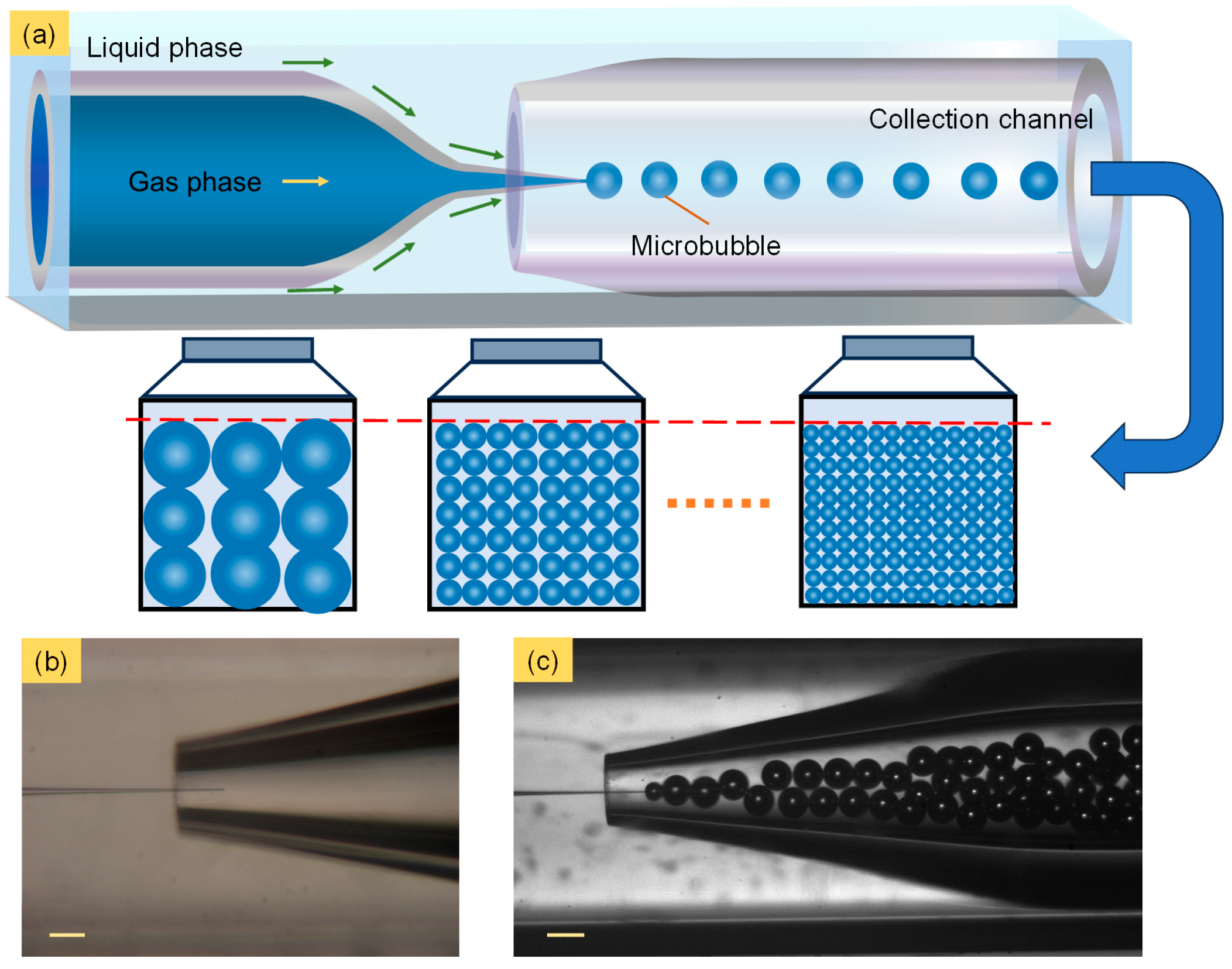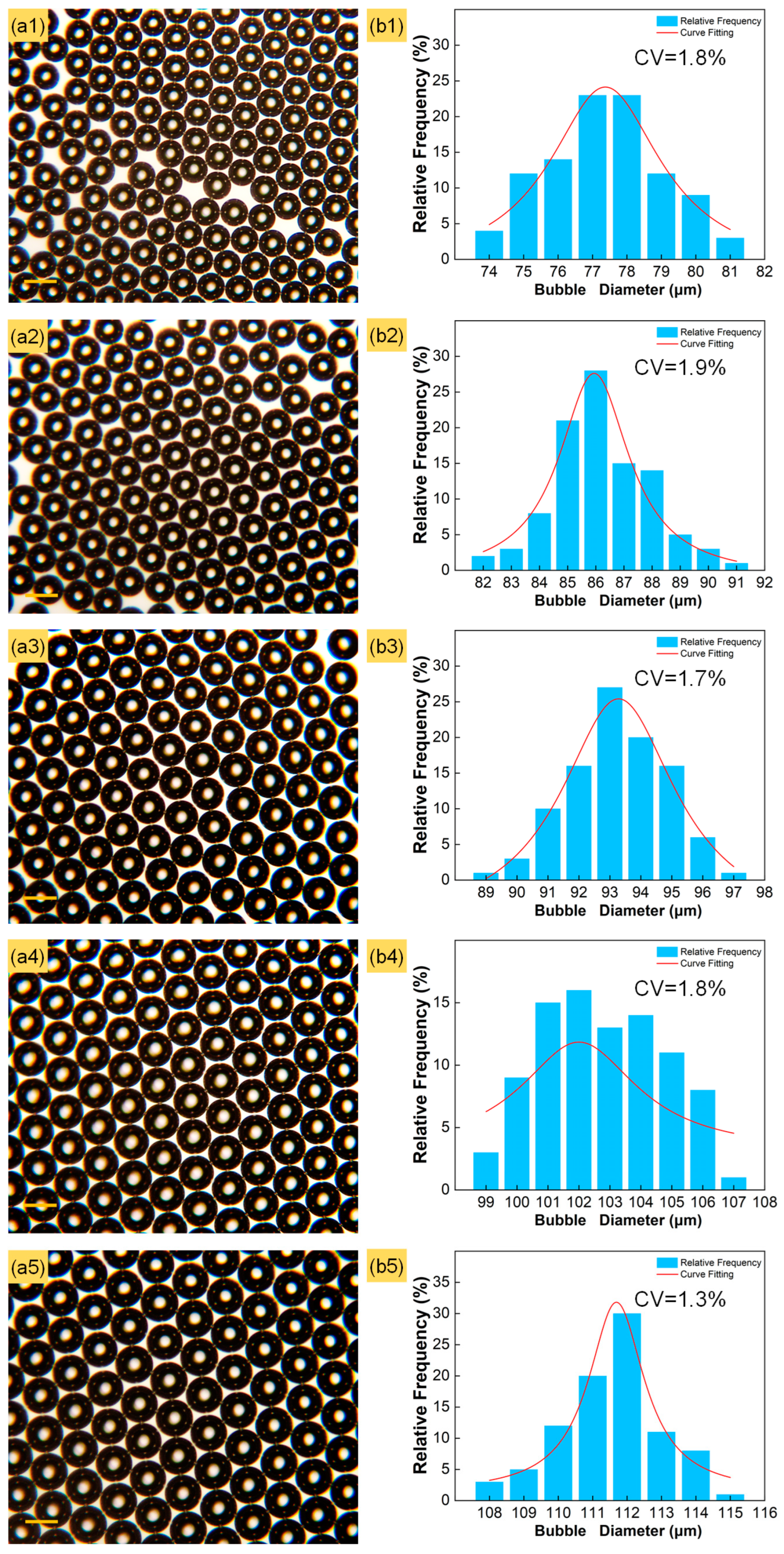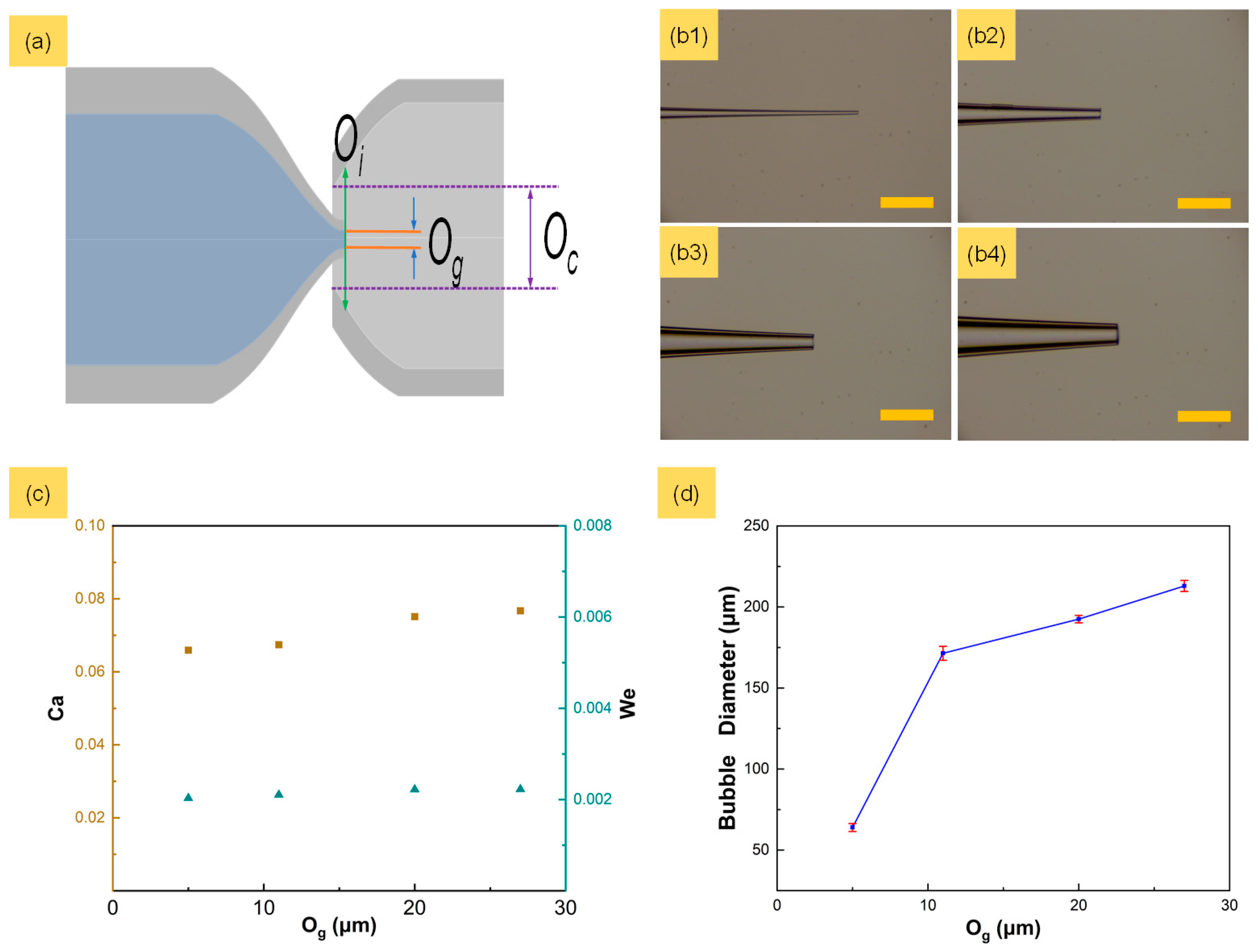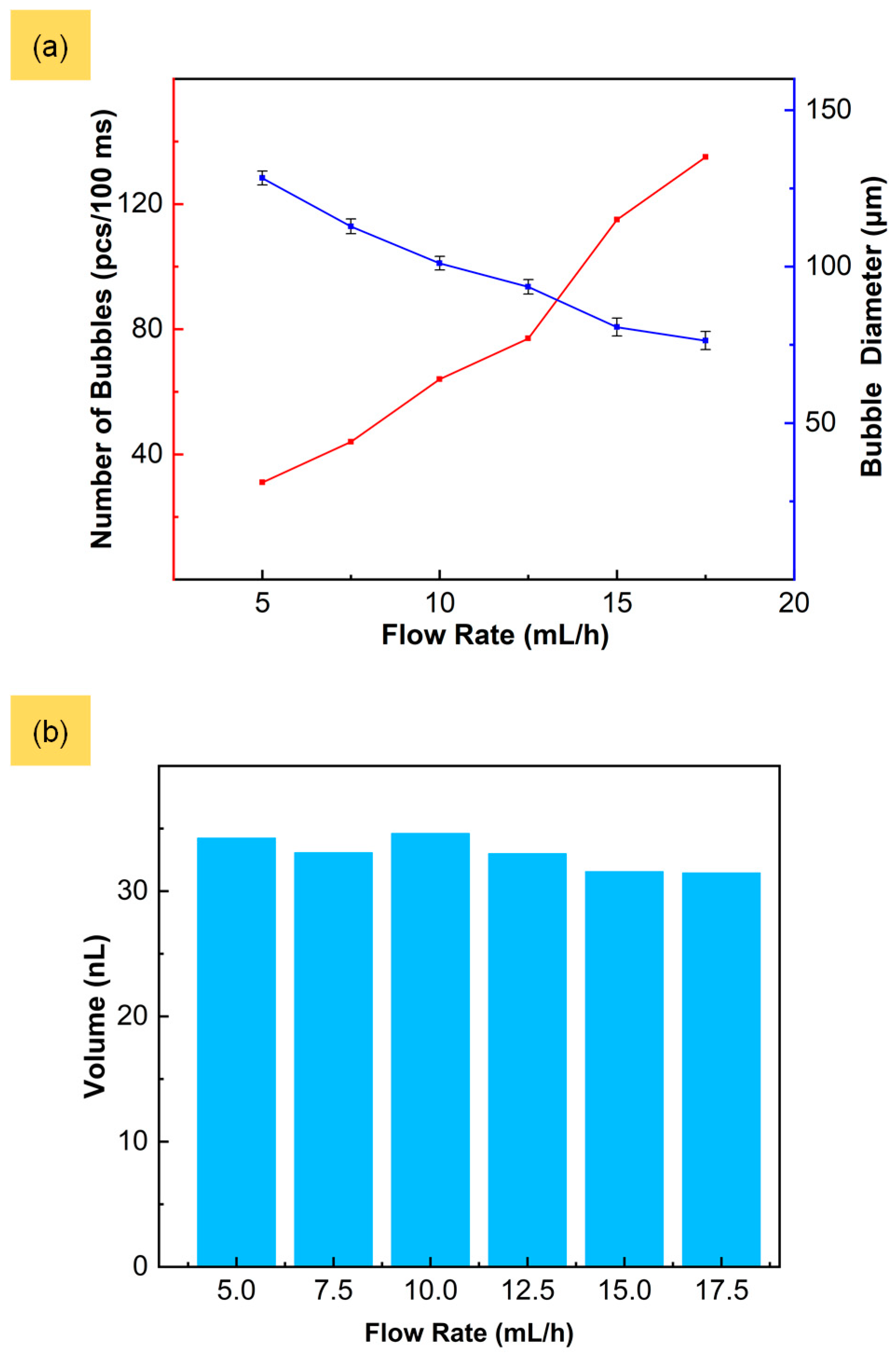High-Speed Generation of Microbubbles with Constant Cumulative Production in a Glass Capillary Microfluidic Bubble Generator
Abstract
1. Introduction
2. Materials and Methods
2.1. Materials
2.2. Fabrication of the Microbubble Generator
2.3. Generation Process of Microbubbles
3. Results and Discussion
3.1. Uniformity of Microbubbles at Various Input Gas Pressures
3.2. Effect of Different Gas Channel Orifices on Microbubble Diameter
3.3. Constancy of Cumulative Microbubble Production at Various Liquid Phase Flow Rates
4. Conclusions
Supplementary Materials
Author Contributions
Funding
Data Availability Statement
Conflicts of Interest
References
- Vilela, D.; Cossio, U.; Parmar, J.; Martinez-Villacorta, A.M.; Gomez-Vallejo, V.; Llop, J.; Sanchez, S. Medical Imaging for the Tracking of Micromotors. ACS Nano 2018, 12, 1220–1227. [Google Scholar] [CrossRef]
- Abenojar, E.C.; Nittayacharn, P.; de Leon, A.; Perera, R.; Wang, Y.; Bederman, I.; Exner, A.A. Effect of Bubble Concentration on the In Vitro and In Vivo Performance of Highly Stable Lipid Shell-Stabilized Micro- and Nanoscale Ultrasound Contrast Agents. Langmuir 2019, 35, 10192–10202. [Google Scholar] [CrossRef] [PubMed]
- Wang, Y.; Li, X.; Zhou, Y.; Huang, P.Y.; Xu, Y.H. Preparation of nanobubbles for ultrasound imaging and intracelluar drug delivery. Int. J. Pharmaceut. 2010, 384, 148–153. [Google Scholar] [CrossRef] [PubMed]
- Angilè, F.E.; Vargo, K.B.; Sehgal, C.M.; Hammer, D.A.; Lee, D. Recombinant Protein-Stabilized Monodisperse Microbubbles with Tunable Size Using a Valve-Based Microfluidic Device. Langmuir 2014, 30, 12610–12618. [Google Scholar] [CrossRef] [PubMed]
- Lin, H.; Chen, J.; Chen, C. A novel technology: Microfluidic devices for microbubble ultrasound contrast agent generation. Med. Biol. Eng. Comput. 2016, 54, 1317–1330. [Google Scholar] [CrossRef] [PubMed]
- Ullah, M.; Kodam, S.P.; Mu, Q.; Akbar, A. Microbubbles versus Extracellular Vesicles as Therapeutic Cargo for Targeting Drug Delivery. ACS Nano 2021, 15, 3612–3620. [Google Scholar] [CrossRef] [PubMed]
- Gao, Z.; Kennedy, A.M.; Christensen, D.A.; Rapoport, N.Y. Drug-loaded nano/microbubbles for combining ultrasonography and targeted chemotherapy. Ultrasonics 2008, 48, 260–270. [Google Scholar] [CrossRef] [PubMed]
- Jeong, J.; Jang, D.; Kim, D.; Lee, D.; Chung, S.K. Acoustic bubble-based drug manipulation: Carrying, releasing and penetrating for targeted drug delivery using an electromagnetically actuated microrobot. Sens. Actuators A Phys. 2020, 306, 111973. [Google Scholar] [CrossRef]
- Lu, T.; Fan, R.; Delgadillo, L.F.; Wan, J. Stabilization of carbon dioxide (CO2) bubbles in micrometer-diameter aqueous droplets and the formation of hollow microparticles. Lab Chip 2016, 16, 1587–1592. [Google Scholar] [CrossRef]
- Bang, J.H.; Suslick, K.S. Applications of Ultrasound to the Synthesis of Nanostructured Materials. Adv. Mater. 2010, 22, 1039–1059. [Google Scholar] [CrossRef]
- Brugarolas, T.; Tu, F.; Lee, D. Directed assembly of particles using microfluidic droplets and bubbles. Soft Matter 2013, 9, 9046. [Google Scholar] [CrossRef]
- Rodríguez-Rodríguez, J.; Sevilla, A.; Martínez-Bazán, C.; Gordillo, J.M. Generation of Microbubbles with Applications to Industry and Medicine. Annu. Rev. Fluid Mech. 2015, 47, 405–429. [Google Scholar] [CrossRef]
- Chong, W.K.; Papadopoulou, V.; Dayton, P.A. Imaging with ultrasound contrast agents: Current status and future. Abdom. Radiol. 2018, 43, 762–772. [Google Scholar] [CrossRef] [PubMed]
- Stride, E.; Edirisinghe, M. Novel microbubble preparation technologies. Soft Matter 2008, 4, 2350–2359. [Google Scholar] [CrossRef]
- Gao, Y.; Wu, M.R.; Lin, Y.; Xu, J. Trapping and control of bubbles in various microfluidic applications. Lab Chip 2020, 20, 4512–4527. [Google Scholar] [CrossRef] [PubMed]
- Zhao, C.L.; Xie, Y.L.; Mao, Z.M.; Zhao, Y.H.; Rufo, J.; Yang, S.K.; Guo, F.; Mai, J.D.; Huang, T.J. Theory and experiment on particle trapping and manipulation via optothermally generated bubbles. Lab Chip 2014, 14, 384–391. [Google Scholar] [CrossRef] [PubMed]
- Chen, C.R.; Karshalev, E.; Guan, J.G.; Wang, J. Magnesium-Based Micromotors: Water-Powered Propulsion, Multifunctionality, and Biomedical and Environmental Applications. Small 2018, 14, 1704252. [Google Scholar] [CrossRef] [PubMed]
- Jaszczur, M.; Młynarczykowska, A. A General Review of the Current Development of Mechanically Agitated Vessels. Processes 2020, 8, 982. [Google Scholar] [CrossRef]
- Maeda, Y.; Hosokawa, S.; Baba, Y.; Tomiyama, A.; Ito, Y. Generation mechanism of micro-bubbles in a pressurized dissolution method. Exp. Therm. Fluid Sci. 2015, 60, 201–207. [Google Scholar] [CrossRef]
- Davoodi, P.; Feng, F.; Xu, Q.X.; Yan, W.C.; Tong, Y.W.; Srinivasan, M.P.; Sharma, V.K.; Wang, C.H. Coaxial electrohydrodynamic atomization: Microparticles for drug delivery applications. J. Control. Release 2015, 205, 70–82. [Google Scholar] [CrossRef]
- Farook, U.; Stride, E.; Edirisinghe, M.J. Stability of microbubbles prepared by co-axial electrohydrodynamic atomisation. Eur. Biophys. J. Biophy. 2009, 38, 713–718. [Google Scholar] [CrossRef] [PubMed]
- Li, Y.K.; Wang, K.; Xu, J.H.; Luo, G.S. A capillary-assembled micro-device for monodispersed small bubble and droplet generation. Chem. Eng. J. 2016, 293, 182–188. [Google Scholar] [CrossRef]
- Fu, T.T.; Ma, Y.G. Bubble formation and breakup dynamics in microfluidic devices: A review. Chem. Eng. Sci. 2015, 135, 343–372. [Google Scholar] [CrossRef]
- Li, Y.Y.; Liu, X.M.; Huang, Q.; Ohta, A.T.; Arai, T. Bubbles in microfluidics: An all-purpose tool for micromanipulation. Lab Chip 2021, 21, 1016–1035. [Google Scholar] [CrossRef] [PubMed]
- Huerre, A.; Miralles, V.; Jullien, M.C. Bubbles and foams in microfluidics. Soft Matter 2014, 10, 6888–6902. [Google Scholar] [CrossRef]
- Stoffel, M.; Wahl, S.; Lorenceau, E.; Höhler, R.; Mercier, B.; Angelescu, D.E. Bubble Production Mechanism in a Microfluidic Foam Generator. Phys. Rev. Lett. 2012, 108, 198302. [Google Scholar] [CrossRef] [PubMed]
- Zhang, C.; Fu, T.T.; Zhu, C.Y.; Jiang, S.K.; Ma, Y.G.; Li, H.Z. Dynamics of bubble formation in highly viscous liquids in a flow-focusing device. Chem. Eng. Sci. 2017, 172, 278–285. [Google Scholar] [CrossRef]
- Chong, Z.Z.; Tor, S.B.; Loh, N.H.; Wong, T.N.; Gañán-Calvo, A.M.; Tan, S.H.; Nguyen, N.T. Acoustofluidic control of bubble size in microfluidic flow-focusing configuration. Lab Chip 2015, 15, 996–999. [Google Scholar] [CrossRef] [PubMed]
- Sheng, L.; Ma, L.; Chen, Y.; Deng, J.; Luo, G. A comprehensive study of droplet formation in a capillary embedded step T-junction: From squeezing to jetting. Chem. Eng. J. 2022, 427, 132067. [Google Scholar] [CrossRef]
- Pancholi, K.; Stride, E.; Edirisinghe, M. Dynamics of bubble formation in highly viscous liquids. Langmuir 2008, 24, 4388–4393. [Google Scholar] [CrossRef]
- Brugarolas, T.; Park, B.J.; Lee, M.H.; Lee, D. Generation of Amphiphilic Janus Bubbles and Their Behavior at an Air–Water Interface. Adv. Funct. Mater. 2011, 21, 3924–3931. [Google Scholar] [CrossRef]
- Wang, Z.L. Speed up bubbling in a tapered co-flow geometry. Chem. Eng. J. 2015, 263, 346–355. [Google Scholar] [CrossRef]
- Lin, X.; Bao, F.; Tu, C.; Yin, Z.; Gao, X.; Lin, J. Dynamics of bubble formation in highly viscous liquid in co-flowing microfluidic device. Microfluid Nanofluid 2019, 23, 74. [Google Scholar] [CrossRef]
- Zhang, J.M.; Li, E.Q.; Thoroddsen, S.T. A co-flow-focusing monodisperse microbubble generator. J. Micromech. Microeng. 2014, 24, 035008. [Google Scholar] [CrossRef]
- Wang, K.; Xie, L.S.; Lu, Y.C.; Luo, G.S. Generating microbubbles in a co-flowing microfluidic device. Chem. Eng. Sci. 2013, 100, 486–495. [Google Scholar] [CrossRef]
- Vagner, S.A.; Patlazhan, S.A.; Serra, C.A.; Funfschilling, D.; Kulichikhin, V.G. Dripping and jetting of semi-dilute polymer solutions co-flowing in co-axial capillaries. Phys. Fluids 2021, 33, 062002. [Google Scholar] [CrossRef]
- Lu, W.; Li, E.Q.; Gao, P. Generation of microbubbles via a tapered capillary. Phys. Fluids 2023, 35, 122103. [Google Scholar] [CrossRef]
- Segers, T.; de Rond, L.; de Jong, N.; Borden, M.; Versluis, M. Stability of Monodisperse Phospholipid-Coated Microbubbles Formed by Flow-Focusing at High Production Rates. Langmuir 2016, 32, 3937–3944. [Google Scholar] [CrossRef]
- Mei, L.P.; Jin, M.L.; Xie, S.T.; Yan, Z.B.; Wang, X.; Zhou, G.F.; van den Berg, A.; Shui, L.L. A simple capillary-based open microfluidic device for size on-demand high-throughput droplet/bubble/microcapsule generation. Lab Chip 2018, 18, 2806–2815. [Google Scholar] [CrossRef]
- Anna, S.L. Droplets and Bubbles in Microfluidic Devices. Annu. Rev. Fluid Mech. 2016, 48, 285–309. [Google Scholar] [CrossRef]
- Chung, K.Y.; Mishra, N.C.; Wang, C.C.; Lin, F.H.; Lin, K.H. Fabricating scaffolds by microfluidics. Biomicrofluidics 2009, 3, 2. [Google Scholar] [CrossRef] [PubMed]
- Pan, D.W.; Zhang, Y.J.; Zhang, T.X.; Li, B. Flow regimes of polymeric fluid droplet formation in a co-flowing microfluidic device. Colloid Interface Sci. Commun. 2021, 42, 100392. [Google Scholar] [CrossRef]
- Zhu, P.G.; Tang, X.; Wang, L.Q. Droplet generation in co-flow microfluidic channels with vibration. Microfluid Nanofluid 2016, 20, 47. [Google Scholar] [CrossRef]
- Bhunia, A.; Pais, S.C.; Kamotani, Y.; Kim, I.H. Bubble formation in a coflow configuration in normal and reduced gravity. AIChE J. 1998, 44, 1499–1509. [Google Scholar] [CrossRef]
- Sun, L.; Fan, M.; Yu, H.; Li, P.; Xu, J.; Qin, H.; Jiang, S. Microbubble characteristic in a co-flowing liquid in microfluidic chip. J. Dispers. Sci. Technol. 2019, 41, 992–1001. [Google Scholar] [CrossRef]
- Xiong, R.; Bai, M.; Chung, J.N. Formation of bubbles in a simple co-flowing micro-channel. J. Micromech. Microeng. 2007, 17, 1002–1011. [Google Scholar] [CrossRef]




Disclaimer/Publisher’s Note: The statements, opinions and data contained in all publications are solely those of the individual author(s) and contributor(s) and not of MDPI and/or the editor(s). MDPI and/or the editor(s) disclaim responsibility for any injury to people or property resulting from any ideas, methods, instructions or products referred to in the content. |
© 2024 by the authors. Licensee MDPI, Basel, Switzerland. This article is an open access article distributed under the terms and conditions of the Creative Commons Attribution (CC BY) license (https://creativecommons.org/licenses/by/4.0/).
Share and Cite
Yu, J.; Cheng, W.; Ni, J.; Li, C.; Su, X.; Yan, H.; Bao, F.; Hou, L. High-Speed Generation of Microbubbles with Constant Cumulative Production in a Glass Capillary Microfluidic Bubble Generator. Micromachines 2024, 15, 752. https://doi.org/10.3390/mi15060752
Yu J, Cheng W, Ni J, Li C, Su X, Yan H, Bao F, Hou L. High-Speed Generation of Microbubbles with Constant Cumulative Production in a Glass Capillary Microfluidic Bubble Generator. Micromachines. 2024; 15(6):752. https://doi.org/10.3390/mi15060752
Chicago/Turabian StyleYu, Jian, Wei Cheng, Jinchun Ni, Changwu Li, Xinggen Su, Hui Yan, Fubing Bao, and Likai Hou. 2024. "High-Speed Generation of Microbubbles with Constant Cumulative Production in a Glass Capillary Microfluidic Bubble Generator" Micromachines 15, no. 6: 752. https://doi.org/10.3390/mi15060752
APA StyleYu, J., Cheng, W., Ni, J., Li, C., Su, X., Yan, H., Bao, F., & Hou, L. (2024). High-Speed Generation of Microbubbles with Constant Cumulative Production in a Glass Capillary Microfluidic Bubble Generator. Micromachines, 15(6), 752. https://doi.org/10.3390/mi15060752





